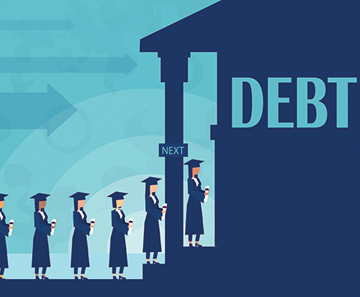As summer winds down, your business’s financial statements may be due for a quick check-up. Here are several review suggestions to help determine the health of your business prior to year-end.
- Balance sheet reconciliations. Reconcile each asset and liability account every quarter. A well-supported balance sheet can guide decisions about cash reserves, debt financing, inventory management, receivables, payables, and property. Regular monitoring can highlight vulnerabilities, providing time for corrective action.
- Debt service coverage. Do you have enough cash to adequately handle principal and interest payments? Calculate your cash flow to ensure you can handle both current and future monthly loan payments.
- Projected revenue. Take a look at your income statements and see how your revenue has performed so far this year versus what you thought your revenue was going to be. If revenue varies from what you expect, get with your sales and marketing team to pinpoint what has gone better, or worse, than expected.
- Projected expenses. Put a stop to disappearing cash by conducting a variance analysis of your expenses. What did you expect to spend so far in 2021 on salaries and wages compared to what you actually paid your employees? What about other big expenses like rent or insurance? Take the amount of money actually spent so far in 2021 in each of your major expense accounts and compare it to your spending forecast. Then create an updated forecast for the balance of the year.
A review of your financial statements now will help you be prepared if you need to navigate an obstacle or capitalize on potential opportunities to expand your business.
 The first advance payment from the newly expanded child tax credit was recently sent out by the IRS. Payments are scheduled to be made on the 15th of each month through December.
The first advance payment from the newly expanded child tax credit was recently sent out by the IRS. Payments are scheduled to be made on the 15th of each month through December.
Here’s what you need to know about the child tax credit and the advance payments.
Background
For the 2021 tax year, an expanded child tax credit reduces your tax bill by $3,600 if you have a qualifying child that’s age 5 or under, or by $3,000 if you have a qualifying child from age 6 to 17.
If the total amount of the child tax credit for your family exceeds the total taxes you owe, you’ll receive the amount of the credit as a refund.
Child tax credit advance payments
Instead of waiting to file your tax return to receive the entire amount of your child tax credit, the IRS is directed by Congress to send 50% of the credit to you in six monthly payments beginning in July 2021.
For example, say you have three kids, ages 10, 12 and 16. Also assume your income is not too high and your children meet the IRS definition of a qualifying child. Instead of waiting until 2022 when you file your 2021 tax return to receive the entire $9,000 child tax credit, you can get paid half of the child tax credit amount, or $4,500, in 2021.
The advance payments began July 15 and continue for six months until December 15. The family in this example would receive six payments of $750 starting July 15, for a total of $4,500.
What you need to know
The monthly payments are automatic. You’ll automatically receive advance payments if:
- You filed a 2019 or 2020 tax return and claimed the credit, OR
- You gave information in 2020 to receive the Economic Impact Payment using the IRS non-filer tool, AND
- The IRS thinks you are eligible, AND
- You did not opt-out of the early payments.
Register with the IRS. If you didn’t file a 2019 or 2020 tax return but are otherwise eligible for the child tax credit, you’ll need to register with the IRS to receive the child tax credit. Click here to visit the IRS website to find out if you need to register.
Consider if you should opt out of the advance payments. Getting half of your child tax credit ahead of time may not be the right move for everyone. For example, if your 2021 income ends up higher than expected, you may need to pay back the advance payments when you file your tax return. To opt out, click here to visit the IRS’s child tax credit update portal.
Paying bills is an inevitable part of everyday life, but that doesn’t mean it has to be stressful. Here are some ways to get control of your budget and perfect the art of stress-free bill paying.
- Make a budget. Knowing what you are making and what you are spending is essential to proper bill paying. First, find out how much you are making every month and then subtract the static items such as rent or mortgage payments, credit card payments and cell phone expenses. Then, budget out how much you will need for other essentials (such as food and clothing). Once the essentials are accounted for, you can look at the money you have left and decide where to allocate the rest.
- Find a budget tool that works. One of the best ways to get a handle on your finances is to use a budgeting app such as Intuit’s Mint or PocketGuard. You can securely link your bank accounts to these apps and download all your transactions in the app. Your bank may also have an app to track your spending, so also check with them. You can then choose which tools to use to make a budget and categorize the transactions to be allocated to a certain part of the budget (such as food, car, housing, etc.).
- Set up autopay. Put recurring bills such as utilities, internet, and your cell phone on autopay so they will be automatically deducted from your account on their due date. If you decide to use autopay, it is still a good idea to look at the amounts being deducted every month to make sure everything is correct.
- Consider your non-regular payments. Don’t forget to account for bills that come due occasionally and plan for the cash outlay. Common examples of this are property tax payments, income taxes, and annual/semi-annual insurance payments. You will need to plan to have enough cash on hand for these expenses when they come due.
- Adjust due dates. Paying bills isn’t as stressful when you know that you can afford to pay them, and what better time to pay bills than right after you get paid! The money will be there and you can pay those bills before that money has a chance to go anywhere else. Consider asking if you can change the due dates for some or all of your bills to correspond with when your paychecks are deposited into your bank account.
- Don’t forget to pay yourself! One of the best ways to start developing a savings account is making yourself part of your budget! Take however much you think you can spare and set up an automatic transfer to a separate savings account. Use this money to establish an emergency fund of approximately six to nine months of expenses. This extra cushion will come in handy if something unexpected occurs.
With the onset of COVID-19, small business banks are more nervous about potential loan losses than ever. Here are several tips for your business to maintain a great working relationship with your lender. These same tips can also be used if you want to plant seeds with your banker for potential future loans.
- Produce timely financial statements. Your lender may require you to produce financial statements over the duration of your loans to ensure that you have enough cash to make consistent, on-time payments. Strive to produce up-to-date financial statements and send them to your bank before they ask for them. Not only will timely financial statements make your lenders happy, the pro-active nature of your financials will show a level of transparency to them. Be prepared to include a note explaining major changes and schedule regular phone calls to go over the business.
- Implement solid internal controls. How does a lender have faith that the dollar amounts on your financial statements are accurate? By properly implementing internal controls. You’ll have a happy banker if your company can provide evidence that your internal controls are operating properly.
- Communicate. If your business encounters turbulent financial waters, the best thing to do is immediately let your lender know about it. Better yet, by keeping in constant communication, your lender will most likely be able to spot if your business starts experiencing a downturn and will try devising a plan before you begin missing payment deadlines.
 Remember, your banker probably has their hands full right now. These tips allow them to spend more time on their problem loans, and one of them will not be yours.
Remember, your banker probably has their hands full right now. These tips allow them to spend more time on their problem loans, and one of them will not be yours.

 According to the Federal Reserve, U.S. student loan debt is now $1.5 trillion with more than 44 million borrowers. Only mortgage debt currently has bigger numbers among types of consumer debt. Even worse, more than 10 percent of these loans are past due. Here are some tactics to help make student debt easier to manage:
According to the Federal Reserve, U.S. student loan debt is now $1.5 trillion with more than 44 million borrowers. Only mortgage debt currently has bigger numbers among types of consumer debt. Even worse, more than 10 percent of these loans are past due. Here are some tactics to help make student debt easier to manage:
- Know the loan terms. Not all student debt is created equal. Understanding the terms of all your student loans is important. With this knowledge, select the correct loan option and know which loan to pay first. Things you should know about each loan include:
- The interest rate
- The term of the loan
- Amount of any upfront fees
- Pre-payment penalties (if any)
- When interest and payments start
- Payment amounts
- Payment flexibility
- How the interest is calculated
Suggestion: Create a spreadsheet with a student loan in each column. Then note the terms under each loan. This will create a strong visual of your situation and show you which loans are most important.
- Avoid accruing interest. Some student loans accrue interest while you are in school. With the compounding of this interest, your student loan amount continues to grow with each passing year before repayment begins. Banks love this — you should not.
Suggestion: Figure out how to make some or all of the interest payments while in school. This will not only lock the amount you owe, it will reduce the amount of overall loan payments.
- Pay a little extra in the early days. The math of loans benefits banks in the early years of the repayment period. This is because the vast majority of interest is paid in the first years of repayment. By the time you get to the last year of repayment, payments are primarily the principal balance and interest is nil.
Suggestion: Pay extra every month as soon as payments start. While this seems impossible as you enter the workforce, even $25 extra per month can dramatically reduce the amount of total payments you make over the life of your loan. For example, a $25 extra payment on a 10-year $50,000 student loan with 5 percent interest would cut six months off the loan, save $834 in interest, AND save $3,180 in future loan payments!
- Make small cuts elsewhere. Having a hard time finding a few extra dollars to make extra payments? Consider observing and then changing your spending habits.
Suggestion: Purchase one less latte a week. Drop one monthly service from a bill. Eat in more often. Then use these savings as a bonus payment on your student loan principal.
While student debt is often an unavoidable outcome of getting a college education, it can be minimized if actively managed. Small changes can yield results if planned for in advance.
In an effort to reduce the amount of money paid to identity thieves who file fraudulent returns, the IRS will be implementing changes in the timing and way they handle the processing of tax returns.
These steps will continue to evolve, but recent changes will impact millions who depend on receiving an early refund.
Earlier filing of form W-2s and 1099-MISC – The timing required to send these forms to employees and vendors remains the end of January. However, the extended deadline for filing the electronic version of these forms to the IRS and Social Security Administration is now a full month earlier. This is done to allow the IRS to match records with early filed tax returns. The prior timing gap was ideal for thieves to file fraudulent tax returns.
Earned Income Tax Credit and Additional Child Tax Credit – If you file a tax return that contains either of these credits, do not expect to receive an early refund. The IRS has been mandated to hold these refund payments until February 15th or later. Given the payment backlog this will create, it is still important to file early to get your refund in the queue.
Begin planning now to be prepared for these upcoming changes. Rest assured, we can all look forward to further changes as the IRS continues to address the multi-billion dollar identity theft problem plaguing the Agency.
Each year a new crop of graduating high school seniors begin their collegiate careers while college graduates consider the opportunities that graduate school provides. As a result, the mountain of student debt continues to build. While this debt is unavoidable, here are some ideas to help make that mountain a little less insurmountable.
Know the note – Not all student debt is created equal. Understanding the terms of all your student loans is important. With this knowledge, select the correct loan option and know which loan to pay first. Things you should know about each loan include:
- The interest rate
- The term of the loan
- Amount of any up-front fees
- Pre-payment penalties (if any)
- When interest and payments start
- Payment amounts
- Payment flexibility
- How interest is calculated
Suggestion: Create a spreadsheet with a student loan in each column. Then note the variables from this list under each note. It will create a strong visual of your student loan situation.
Pay the interest – Some student loans accrue interest while you are in school. With the compounding of this interest, your student loan amount continues to grow with each passing year before repayment begins. Banks love this. You should not.
Suggestion: Figure out how to make the interest payments while in school. This will not only lock the amount you owe, it will reduce the amount of interest payments you will be paying on your interest.
Pay a little extra in the early days – The math of loans benefits banks in the early years of the note. This is because the vast majority of interest is paid by you in the first years of repayment. The last year of your loan repayment is primarily principal payments.
Suggestion: Pay extra every month as soon as payments start. While this seems impossible as you enter the workforce, even $10 extra a month can dramatically reduce the amount of total payments you make over the life of your loan.
While student debt is an unavoidable outcome of getting a great education, it can be minimized if actively managed. Remember small changes can yield results if planned for in advance.